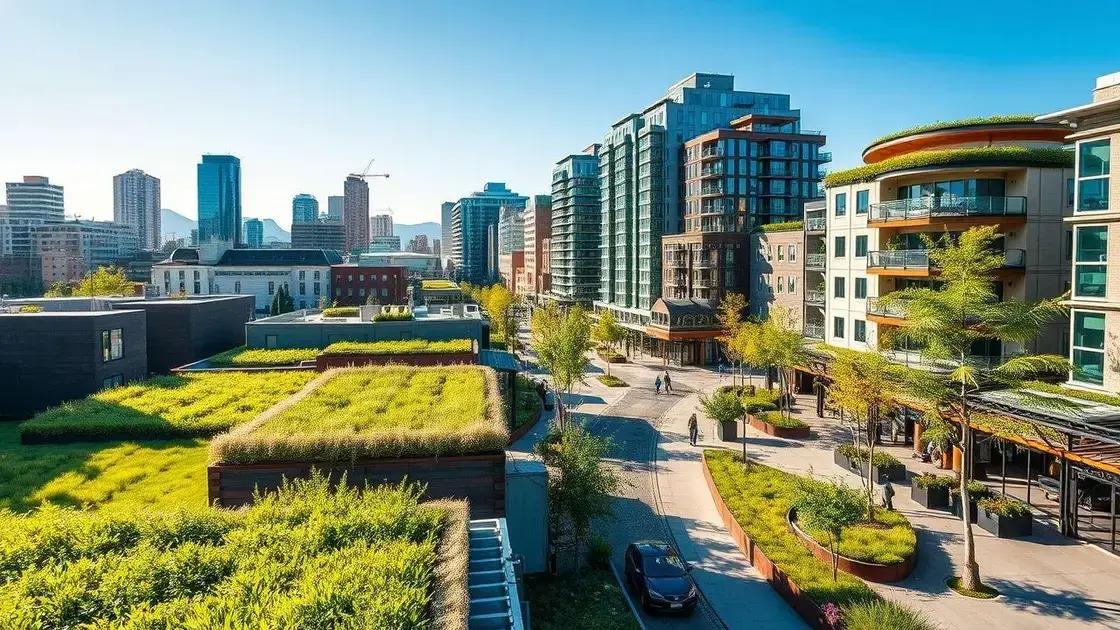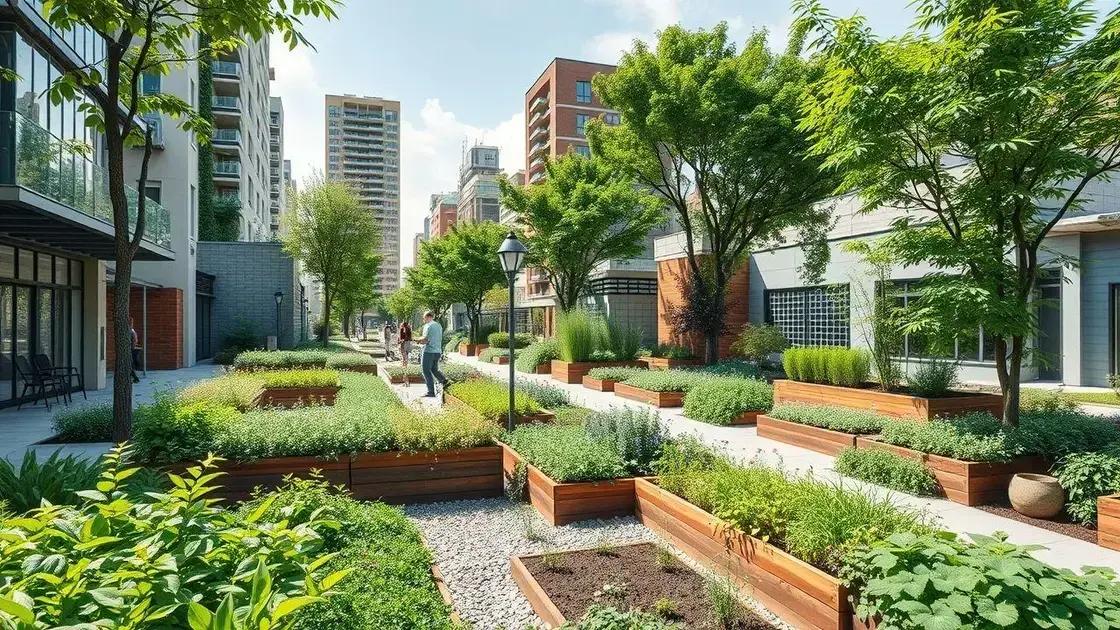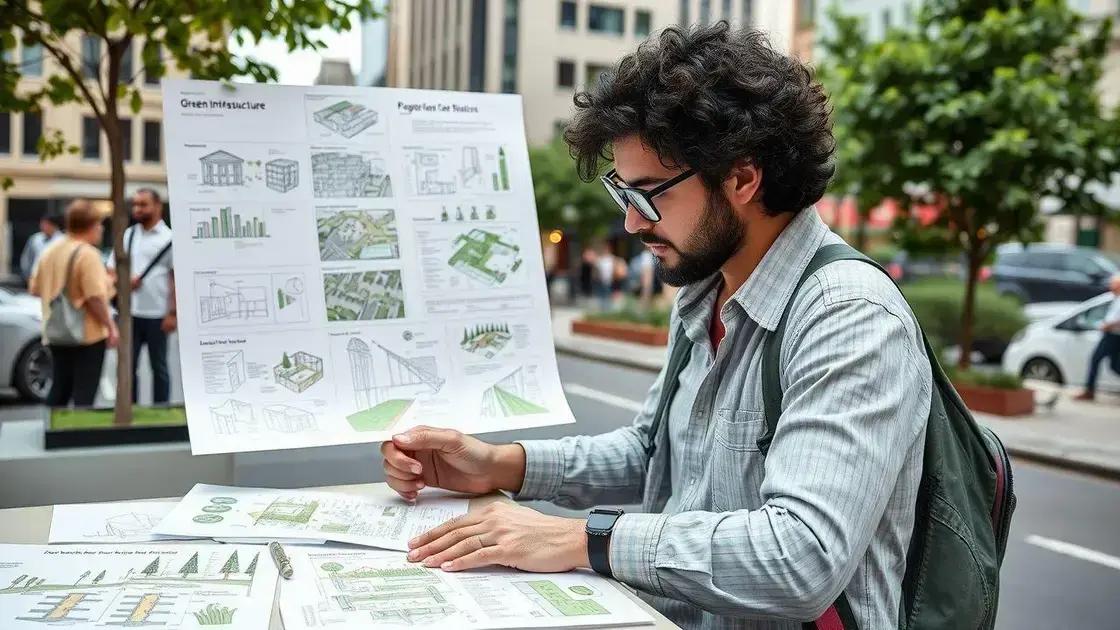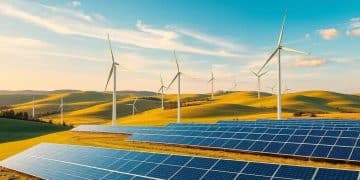Green infrastructure headlines trends shaping our cities

Green infrastructure integrates natural systems into urban planning, improving air and water quality, enhancing community health, and mitigating climate change effects while facing challenges like funding and space limitations.
Green infrastructure headlines trends are at the forefront of urban development discussions today. Have you noticed how cities are increasingly prioritizing sustainability? Let’s dive into how these trends are shaping our environments.
Understanding green infrastructure and its importance
Understanding green infrastructure is essential for creating sustainable cities. It refers to natural and semi-natural systems that provide environmental, social, and economic benefits. By integrating green spaces into urban design, cities can improve air quality, reduce heat, and enhance biodiversity.
The Purpose of Green Infrastructure
Green infrastructure serves multiple purposes. It is designed to manage stormwater, conserve biodiversity, and improve the quality of life for residents. When natural systems are incorporated into urban environments, they can mitigate the impacts of climate change.
Benefits of Green Infrastructure
- Improved Air Quality: Plants filter pollutants, producing cleaner air.
- Stormwater Management: Green roofs and permeable pavements reduce runoff.
- Enhanced Urban Aesthetics: Green spaces make cities more visually appealing.
- Community Health: Access to nature promotes physical and mental well-being.
Moreover, communities benefit from the social connections formed in these green areas. People gather in parks, engage in recreational activities, and build relationships. This fosters a sense of belonging and pride in their environment.
Furthermore, green infrastructure can help combat the urban heat island effect, where cities become significantly warmer than surrounding areas. Elements such as trees and green roofs cool buildings and streets, making cities more livable.
Challenges to Implementation
While the benefits are clear, implementing green infrastructure can face challenges. Funding, space limitations, and maintenance can pose obstacles. However, cities like Portland and Amsterdam have pioneered successful models, demonstrating that overcoming these hurdles is possible.
As we continue to face environmental issues, understanding and implementing green infrastructure is more important than ever. By prioritizing sustainable practices, we can shape cities that thrive both now and in the future.
Key trends in green infrastructure development

Key trends in green infrastructure development are shaping the future of urban planning. As cities strive for sustainability, innovative practices are emerging worldwide. These trends not only create more livable environments but also address pressing environmental issues.
Nature-Based Solutions
Nature-based solutions (NbS) are becoming increasingly popular. This approach integrates natural processes into urban landscapes to manage environmental challenges. For instance, using trees and green roofs can help absorb rainwater, mitigate flooding, and improve air quality.
Increasing Community Involvement
Another trend is the growing involvement of communities in planning. Residents participate in decisions affecting their local green spaces, leading to a stronger sense of ownership. This engagement enhances the relationship between the community and its environment.
Technological Innovations
- Smart Technologies: Sensors and data analysis help monitor green infrastructure performance.
- Green Walls: Vertical gardens improve air quality and utilize limited space.
- Rainwater Harvesting: Systems capture rainwater for irrigation and other uses.
- Sustainable Materials: Eco-friendly materials reduce the environmental impact of construction.
Moreover, public-private partnerships are on the rise. These collaborations harness resources from both sectors, driving the implementation of green infrastructure. This strategy can lead to innovative projects that benefit both the economy and the environment.
As climate change intensifies, cities are increasingly recognizing the need for resilient infrastructure. The focus on sustainability is not merely a trend; it is a necessity for improving urban resilience. By adopting these key trends, cities can create a better future for their residents.
Benefits of implementing green infrastructure
Implementing green infrastructure brings numerous benefits that enhance urban environments. These benefits include ecological, social, and economic improvements that are vital for the sustainability of our cities.
Ecological Benefits
One of the primary advantages is the positive impact on the environment. Green infrastructure helps improve air and water quality, which is essential for healthy urban living. By incorporating green spaces, cities can effectively filter pollutants and manage stormwater.
Social Benefits
On the social side, these infrastructures foster community well-being. Access to green areas encourages physical activity and social interactions among residents. Parks and gardens provide spaces for relaxation and recreation, contributing to improved mental health.
Economic Advantages
- Increased Property Values: Homes near green spaces often have higher property values.
- Cost Savings: Implementing green infrastructure can reduce costs related to flood damage and energy use.
- Job Creation: Developing and maintaining green spaces creates jobs in landscaping and construction.
- Tourism Boost: Attractive green areas can attract visitors, benefiting local businesses.
Additionally, green infrastructure can mitigate the effects of climate change. As temperatures rise, urban areas experience the heat island effect, but green roofs and urban trees can reduce these effects, keeping cities cooler and more comfortable.
Moreover, as cities expand, natural habitats often get disrupted. Implementing green infrastructure can preserve biodiversity by providing habitats for various species. This incorporation supports an ecosystem that benefits both people and wildlife.
Challenges and solutions for urban planners

Urban planners face several challenges when integrating green infrastructure into city designs. These challenges can make it difficult to implement effective solutions that benefit both the environment and communities.
Space Limitations
One significant challenge is space limitations in densely populated areas. Many cities struggle to find enough land to allocate for parks and green roofs. This often leads to conflicts between development needs and green space conservation.
Funding and Resources
Another major hurdle is securing funding for green projects. Urban planners often need to compete for limited budgets, making it challenging to prioritize sustainable initiatives. Without adequate financial resources, many plans cannot be executed effectively.
Public Awareness and Support
- Engagement Initiatives: Organizing community workshops can generate interest and support.
- Education Programs: Informing residents about the benefits of green spaces encourages public backing.
- Partnerships: Collaborating with local businesses can provide additional resources and incentives.
- Advocacy: Raising awareness among city officials helps prioritize green initiatives in planning discussions.
Moreover, planners must navigate regulatory challenges and zoning laws that may restrict the implementation of green infrastructure. These regulations can limit creative solutions that promote environmental sustainability.
On the other hand, innovative technologies can assist in overcoming some of these obstacles. For instance, using data-driven tools can help planners analyze potential locations for green infrastructure effectively and assess the needs of the community.
Additionally, creating pilot projects can demonstrate the benefits of green infrastructure. When residents see successful implementations, they are likely to support expansion efforts in their neighborhoods. This approach builds trust and highlights the importance of integrating nature into urban landscapes.
FAQ – Frequently Asked Questions about Green Infrastructure
What is green infrastructure?
Green infrastructure refers to natural and semi-natural systems in urban areas that provide environmental benefits, such as reducing flooding and improving air quality.
What are the main benefits of implementing green infrastructure?
The main benefits include enhanced air and water quality, increased biodiversity, improved community health, and reduced urban heat.
What challenges do urban planners face with green infrastructure?
Planners often encounter challenges like space limitations, funding issues, and regulatory restrictions that can complicate the implementation of green projects.
How can communities support green infrastructure initiatives?
Communities can support these initiatives by participating in planning, attending workshops, and advocating for green spaces in their neighborhoods.





